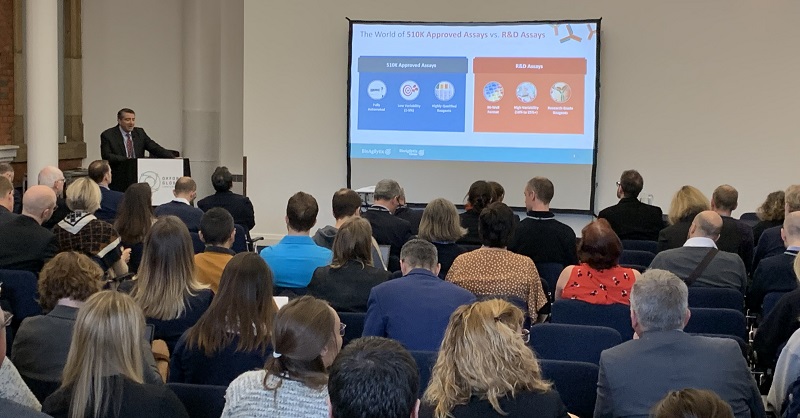Oxford Global’s Annual Biomarkers Congress is an event that we mark on our calendars every year. The lively discussions surrounding key opportunities and challenges in biomarker research are always exciting to hear, and this year was no exception. Our team had the opportunity to both present and attend sessions on timely topics that are bound to shape the future landscape of biomarker discovery and development, and we wanted to share with you a few highlights we found worth noting.
The Importance of Fit-for-Purpose
Several presentations given illustrated and further reinforced the importance of Fit-for-Purpose (FFP) validation for biomarkers. Many presenters referred to Lee et al. (2006), which states that the fit-for-purpose status of a biomarker method is considered acceptable and useful if the assay is capable of discriminating changes that are statistically significant from the intra- and inter-subject variation associated with the biomarker.
I gave an example of this in my own presentation at the conference discussing the challenges and requirements of single and multiplex biomarker validation for regulated studies: an assay with 40% total error allowable determined during validation may be adequate for statistically detecting a desired treatment effect in a clinical trial for a certain acceptable sample size, but this same assay may not be suitable for a clinical trial involving a different study population that has much greater physiological variability.
As such, there was also heavy discussion around the importance of establishing a biomarker assay’s Context of Use (COU). Assay procedure and resulting measurements should be suitable for the biomarker’s intended purpose and COU helps to define the FFP expectations for assay validation.
The Inherent Variability in Biomarkers
A number of sessions also provoked productive discussions on the challenges that biomarkers present as endogenous molecules. Variability in physiology, disease biology, pathology, treatment administered, and environmental factors can cause biomarker measurements to fluctuate. Determining assay acceptance criteria for biomarker assays is likely the most challenging exercise for a biomarker assay validation, as the criteria is dependent upon each biomarker’s physiological behavior.
There were discussions on how early considerations for assay design and technology selection, along with setting minimally acceptable assay performance criteria up front, can help to mitigate these challenges and optimize assay performance in line with expectations.
The Future of Biomarker Validation Guidance
One of the most exciting sessions of the event previewed content of a new white paper that is anticipated to be released later this spring. The paper, entitled “Scientific and Regulatory Considerations for the Analytical Validation of Assays Used in the Qualification of Biomarkers in Biological Matrices”, is expected to set the path for future FDA biomarker validation guidance, and should provide clarity on the scientific and regulatory expectations for biomarker assay performance characteristics and validation to guide biomarker qualification studies.
—
Events like Oxford Global’s Annual Biomarkers Congress are necessary when working in a constantly evolving field of study. My colleagues and I find great value in participating in discussions that allow us to stay on the same page as the entire industry on bioanalytical best practices and novel drug development innovations.
If you would like to hear more about BioAgilytix’s perspective on these and other important topics in bioanalysis today, feel free to reach out to me to continue the conversation.
